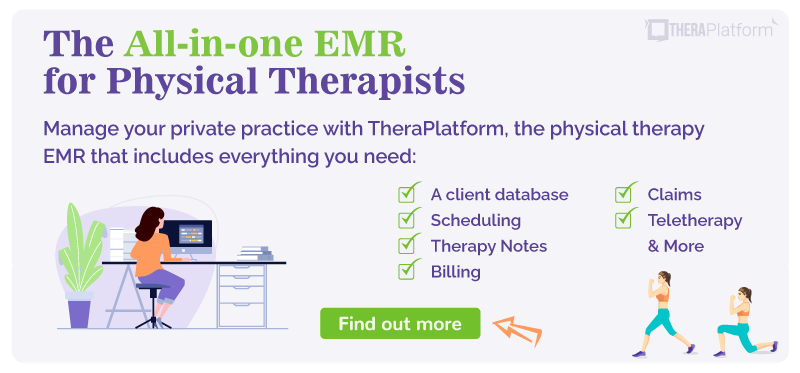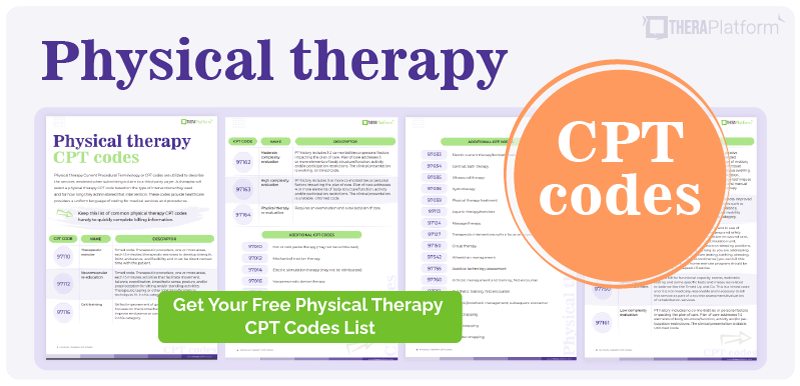Modifier 59

Modifier 59 is one of several codes used for physical therapy billing. Billing and coding are a necessary part of nearly every therapy practice. Unless you work for an exclusively cash-pay practice, submitting billing and CPT codes to insurance companies is how you get reimbursed for all of the great services you provide your patients.
Whether you are a clinic owner or a practicing therapist, having some knowledge about diagnostic codes, CPT codes and their modifiers will help maximize reimbursement and minimize claim denials, something we all strive to achieve. In this article we will delve specifically into the modifier 59, an important aspect of submitting CPT codes, including its purpose and how to utilize this code correctly.
To begin, we will review some common terminology used in medical billing and claims that are important to understand when discussing the use of the 59 modifier.
CPT Codes 101
Let’s start with a basic review of CPT codes. CPT stands for Current Procedural Terminology codes. CPT codes are utilized to describe the physical therapy services rendered when submitting a claim to a third party payer. A therapist will select a CPT code based on the type of intervention they used and for how long they administered that intervention. These codes provide healthcare providers a uniform language of coding for medical services and procedures.
Here are a few examples of physical therapy CPT codes you will probably recognize:
- 97710: Therapeutic Exercise
- 97140: Manual Therapy
- 97161: Low Complexity Evaluation
- 97530: Therapeutic Activity
CPT codes are often undergoing revisions both on the editorial side and the value side so it is important to reference timely CPT code resources such as the American Medical Association, who actually owns the copyright of the CPT codes. In addition, there are CPT codes that are timed based and some follow the 8-minute rule.
Modifier basics
While CPT codes are typically a regular and familiar part of a therapist’s documentation, they may be unfamiliar with or unaware of the existence of modifier codes. Modifiers are two digit codes linked to a CPT code that provide further description and extra details about the service that was provided.
These are some of the common modifiers used with CPT codes:
- Modifier 59
- Modifier XE
- Modifier XS
- Modifier XU
- Modifier XP

National Correct Coding Initiative or NCCI Edit Pairs
If you aren’t heavily involved with claims and billing in your practice, you may have never heard of an NCCI edit pair. NCCI, the National Correct Coding Initiative, was created by the Centers for Medicare and Medicaid Services (CMS) to promote correct coding practices and limit improper coding leading to inappropriate payment in Part B claims.
One of the ways in which the NCCI attempts to limit improper coding is through the development of NCCI Procedure-to-Procedure (PTP) edits which represent pairs of codes that should not be reported together. If a provider reports the 2 codes of an edit pair to the same payer on the same date of service, the first code reported (column 1 code) will be paid while the second code reported (column 2 code) will be denied. In some cases, however, an appropriate CPT modifier can be attached, for example, the 59 modifier, which justifies the payment of both codes.
There is a fairly extensive list of PTP edits related to physical medicine and rehabilitation for things such as evaluations, modalities, therapeutic procedures, orthotics and prosthetics, and wound care. For a full and up-to-date list of code edits, visit the CMS website. When you look at the list of relevant PTP edit pairs, you will notice a modifier indicator of “0” indicates you cannot bill these codes together whereas a modifier indicator of “1” indicates you can do so if you apply the modifier 59.
Let’s take a look at two examples of edit pairs:
Example 1: These codes cannot be billed together (indicator 0)
97161: | 97750: |
|---|---|
Low complexity evaluation | Physical performance test |
Example 2: These codes can be billed together with a Modifier 59 (indicator 1)
97040: | 97018: |
|---|---|
Manual therapy | Paraffin bath |
When to use Modifier 59
If we go back to the concept of NCCI pair edits outlined above, there may be a case when two physical therapy procedures that normally would not both be reimbursed by a payer if reported on the same date of service, are eligible for payment if they each represent a “distinct procedural service.” The Modifier 59 was created to indicate two procedures which are, in fact, distinct enough to warrant payment by a payer source.
Understanding when to use Modifier 59 requires that you are first familiar with which pairs of codes constitutes a “pair edit” and second that you know which codes can never be used together versus which codes can be used together if a correct modifier is applied. The list of NCCI pair edits is not a fixed list but is instead regularly reviewed and updated as often as quarterly which means you need to be regularly consulting the appropriate resources.
According to the Medicare Learning Network’s (MLN) latest fact sheet on Modifier 59, an excellent resource to learn more about the CMS guidelines for this modifier.

What is modifier 59 used for?
Modifier 59 is used appropriately for two services described by timed codes provided during the same encounter only when they are performed sequentially. There is an appropriate use for modifier 59 that is applicable only to codes for which the unit of service is a measure of time (e.g., per 15 minutes, per hour). If two timed services are provided in blocks of time that are separate and distinct (i.e., the same time block is not used to determine the unit of service for both codes), modifier 59 may be used to identify the services.
It is important that your documentation provides justification for the use of the modifier. It should indicate that the column 1/column 2 procedures were performed in separate and distinct blocks of time which meet the time requirements to bill that particular code (ex. 15 min).
Start 30-day Free Trial and explore TheraPlatform. HIPAA Compliant Video and Practice Management Software for Therapists.
Modifier 59 updates
While Modifier 59 used to be the only modifier available to indicate distinct procedural services, since 2015, the X modifiers (XE, XU, XP, XS) were developed to provide even greater specificity and should be utilized whenever possible in lieu of the modifier 59 to provide even greater detail. These codes are used to indicate a separate encounter (XE), separate structure (XS), separate practitioner (XP), and unusual, non-overlapping service (XU).
While it may seem easier to simply apply a modifier 59 or X modifier to all codes to avoid a claim denial that may occur, if you forget to attach the modifier when it is actually indicated, this is not recommended. Attaching modifiers incorrectly or unnecessarily can actually lead to claim denials which means more work for you and your team to fix and resubmit billing, leading to delays in payment.
While many of the common CPT codes you use in your daily practice can be billed together without issue, it is important to be aware of the PTP edits that may affect your practice. The CMS website can provide you with the latest list of coding edits and the Medicare Learning Network’s (MLN) latest fact sheet on Modifier 59 is a great resource to help you understand under which circumstances you can and should apply these modifiers. When in doubt, contact your billing department to help you navigate the latest NCCI edit updates. While billing and claim submission are no therapist’s favorite part of their job, learning a bit more about proper and effective billing practices can go a long way in keeping your practice profitable.
An EHR like TheraPlatform can make billing and coding for reimbursement easier. Built-in tracking and reporting helps you keep up with every client, the services they're receiving, payment statuses and more. TheraPlatform, an all-in-one EHR, practice management and teletherapy tool was built for therapists to help them save time on admin tasks. TheraPlatform is offering a 30-day free trial now. No credit card required. Cancel anytime.
Resources
More resources
- Therapy resources and worksheets
- Therapy private practice courses
- Ultimate teletherapy ebook
- The Ultimate Insurance Billing Guide for Therapists
- The Ultimate Guide to Starting a Private Therapy Practice




